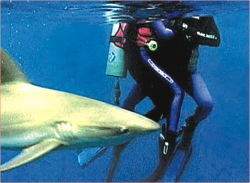 alt...
who are you? Are you sure you are who you think you are? Are you confident
that you are not deceived by your own identity?"
alt...
who are you? Are you sure you are who you think you are? Are you confident
that you are not deceived by your own identity?"
Friends, you must be wondering what
on earth is this article about, asking some scary unusual questions!
These are the very questions that I have been asked as I entered the
newly opened, "International Spy Museum" on the F. Street,
Washington. In a dark room, locked from every side, visitors panicking
and desperately trying to figure out.." what on earth is going
on?" and everyone helplessly looking around. Such was the situation
in the magnificent spy museum, where the history of "espionage"
has been preserved and displayed for the first time.
The questions were a part of the mysterious
game that we had to play as we entered the magnificent museum,. The
game was simple; we were given a separate identity, a separate outlook
(on pictures) and a mission. We were undercover (just like the spies)
and the game was to spy on other spies (other visitors) and detect
them from the few details that were provided.
As we gradually enter the museum with
racing pulses and hearts thumping (probably the feeling of being a
spy and detecting spies in a "spy museum" was enough for
an adrenaline outburst) and confusion written all over our mind, a
maxim catches my eyes stating, "An obvious truth is an obvious
mystery" (Sherlock Holmes).
We cautiously enter a dark room and
to our amazement the door shuts down all of a sudden. The light glows
off followed by the famous "James Bond" music and shadows
of people running all over the huge screens with arms on hand firing
at all of us. The sound effect was so realistic that it was as if
Mr. Bond was beside us and his enemies firing at him. Everything happened
so quickly that some of us were on knees trying to avoid the bullets
that was being fired at us! And guess what is next... yes you're right,
the beautiful young girls in our group screamed their heart-out testing
the highest level that their vocal cord can tolerate. Trust me! It
was about bizillion decibels and amazingly sounded melodious!
Each and every compact detail is shown
in the "short film" which has not only surprised me but
left with a question as well. Why do people choose to spy? Is it for
patriotism, money or just for adventure? Nobody seems to have an answer
to this question.
"International Spy Museum"
consists of the world biggest collection of the espionage artifacts
that have been displayed publicly for the very first time. The 40
million dollar museum consists of five buildings and is very close
to the FBI headquarters in Washington. Interestingly, one of the five
buildings (The Atlas Building) housed one of the former headquarters
of the U.S Communist Party from 1941 to 1948.
I came to know that, it was George
Washington who was the first person to introduce espionage to the
Americans. In February 1777 Washington gave a New York man the go-ahead
to establish a spy network in the region and promised him $50 a month
"for your care and trouble in this business". The one-page
letter, written in Washington's meticulous slanted script, hasn't
been publicly displayed since it was reproduced in a newspaper in
1931. And this very historic letter is one of the principal attractions
of this section.
Next comes the "World War"
section. This is obviously the best of all because spying was at it's
best during the period to bring glory and pride to their countries.
This is where one can learn the different ways FBI and KGB adopted
to outsmart each other. Learn about "The Cold War" and the
"War Of Intelligence" between these spies. It was interesting
to know how technology was used at that moment and the limitations
of it. And the obviously the fun bit was figuring out the "secret
codes" and to learn about the experts who made them and who broke
them. All these days we knew the history, over here you'll get to
learn the secret history.
World War section revealed the dark
cloud of suspense and confusion that hid the world during wars but
couldn't stop the spies from operating. The American, German and Russian
spies operated right at each other's noses. Here, obviously the questions
comes why wasn't the spies recognized? Well, the way they disguised
themselves as others with make up, beards and moustaches... it was
hard to pick out the original one. From the way the person to be disguised
talks, to the way he walks and the accent he speaks in., everything
is perfectly mastered by the spies before they go on a mission.
In this section, you can try your
own code breaking skills. Spies always give their highest priority
to codes, as they believe "a code can shorten a war" and
the famous phrase "a broken code is a broken hand".
Among the displayed weapons there
were, a World War II German cipher machine commonly known as Enigma.,
a shoe from the 1960 with a Soviet listening device embedded in the
heel, A Czech-made remote-control Robot that was used to secretly
record private conversations. T1-340 camera used by the East Germans
in the 1980's to take photographs in hotel rooms. And the best of
all was a lipstick pistol that was called the "Kiss of Death"
produced by the KGB during the 1960. This contains a 4.5 mm, single-shot
weapon, encased in a plastic tube and was first detected in a Berlin
Border crossing. And if you question the accuracy, here is what Keith
Melton (who is in charge of this section) has to say. "At close
range, right next to the person, behind the head, it would be devastatingly
accurate!"
More interesting were the forged British
pounds that were used by the Nazis during the World War II. Another
fascinating Soviet discovery was an umbrella that had a gun attached
to its bottom and could deliver fatal poison. It was used in an infamous
case when Bulgarian defector and writer Georgi Markov was stabbed
with a poison umbrella in London in 1978and died four days later.
Police believed the assassin was a KGB agent.
The KGB also used small lightweight
F21 cameras for various methods of clandestine photography, including
concealing camera behind coat buttons. The KGB also used the shoe
and a radio-transmitter, microphone and batteries embedded in the
heel. The idea was for a maid or valet to sneak these enhanced shoes
into the target's closet and then activate the heel's transmitter
before the target left home for the day, allowing agents nearby to
monitor all conversations. Tthe role of photography in espionage will
be evident throughout the museum. The collection includes KGB photographs
of equipment found in wreckage of Francis Gary Power's U-2 spy plane,
shot down by the Soviets in 1960.
One of the contemporary artifacts
is a mailbox used as a "dead drop" by Aldrich Ames, the
CIA officer who spied for the Soviet Union in the 1980s and 1990s.
He marked this mailbox located in Georgetown, as a signal that he
was ready to talk with his Soviet contacts. Besides, there is also
a "hi-tech" spy camera that was embedded in tree stumps
and had wires that looked thinner than hair. The most intriguing section
intriguing (or scary) exhibit my be the eavesdropping station, where
you can pick up a pair of headphones and listen in on conversations
captured by bugs located in other parts of the museum.
The last section of the museum contains
books, movies of different spies ranging from James Bond to Sherlock
Holmes and others. There was also a BMW (probably the one used in
"Tomorrow Never Dies") displayed. The headlights had machine
gun hidden underneath and there were sharp spikes attached to the
sides of the car that which was enough to destroy any adjacent vehicle.
There's also a separate section where
one can enrich their general knowledge with exciting facts like: There
were more than 20,000 spies only in Washington during the Cold War.
The U.S capital still remains the paradise for spies as even today,
more spies infiltrate the streets of Washington D.C, than any other
place in the world. Besides, you get to learn about the pervasiveness
of Stasi where husbands practiced spying on wives. Vladmir Putin,
the Russian President, is an example as he was a top official of the
KGB and probably by now has made his wife's life a "living-hell"!
(there was an article on "Prothon Alo" about this).
The International Spy Museum has already
been a major attraction to any tourist visiting United States. A leading
U.S daily newspaper wrote that the museum "explores the craft,
history and contemporary role of espionage, and is the only one in
the world to provide a global perspective on an all-but-invisible
profession that has shaped history and continues to have a significant
impact on the world events". Talking about the need for such
a museum, Milton Maltz (chairman of the advisory board) said "in
a democracy it is especially important for the public to have a more
realistic understanding of the intelligence business so we appreciate
the role in our society and impact upon our major world events".
So there you go, a great museum with a committed team working behind
such a noble cause.
Trust me friends, seeing the enormous
adventure in spying, I almost decided to set my ambitions of being
a spy. But who would want to enter a world of uncertainty where suicide
is the second best option (the first being escape). After all.. its
not that easy as Mr. James Bond makes it look like. So anyone of you
planning a visit to States must keep "International Spy Museum"
in the top priority list.

Anime review
RahXephon
 The
best way for someone to be introduced to genuine, serious anime is
probably Cowboy Bebop, though Pokemon fans worldwide will probably
say otherwise. However your initiation be, though, you can't make
much of a mistake picking up RahXephon the TV series... for the 26
episodes will unfailingly captivate you and the DARING of the creators
will leave you going "wow!"
The
best way for someone to be introduced to genuine, serious anime is
probably Cowboy Bebop, though Pokemon fans worldwide will probably
say otherwise. However your initiation be, though, you can't make
much of a mistake picking up RahXephon the TV series... for the 26
episodes will unfailingly captivate you and the DARING of the creators
will leave you going "wow!"
The Synopsis:
Kamina Ayato is your average 17 year old, going to school in Tokyo,
and to his knowledge in a previous world war the rest of the planet's
been destroyed... all that's left is the 6 million people of Tokyo.
Not that it matters... until one day on his way to school he comes
across titanic mecha in battle with fighters over his head, and is
guided by a mysterious girl (Reika Mishima) to a place where he fuses
with a gigantic robot... and discovers that the people of Tokyo bleed
blue blood? What gives?
 If
you've ever seen Neon Genesis Evangelion - another legend in anime
history - the plot may seem just a bit familiar to you; if you haven't,
so much the better. Regardless of your anime background, though, Rahxephon
will grip you with fluid animation, a story whose scope is titanic
to put it mildly, incredible pacing, and characters you're bound to
love.
If
you've ever seen Neon Genesis Evangelion - another legend in anime
history - the plot may seem just a bit familiar to you; if you haven't,
so much the better. Regardless of your anime background, though, Rahxephon
will grip you with fluid animation, a story whose scope is titanic
to put it mildly, incredible pacing, and characters you're bound to
love.
This is not your
average kiddy show, though, and that makes itself evident in the feel
of the entire series... and viewers should watch it at their own discretion.
Despite all that, though, RahXephon remains one of this reviewers
favourites... and a grand way for anyone who can take the time to
get acquainted to some great anime.
<you
should be able to find Rahxephon on kazaa... otherwise, the best option
I know is to go to www.baka-ost.net and (ahem) pay up the enormous
sum of 5 dollars... also, if you want to try before you buy, I suggest
you sign up at animemusicvideos.org and download koopsikeva's Euphoria
AMV... it's a great song for a great anime..
Open Water
Review by Gokhra
 Cast:
Cast:
Susan: Blanchard Ryan
Daniel: Daniel Travis
Seth: Saul Stein
Estelle: Estelle Lau
Davis: Michael E. Williamson
Junior: John Charles
Linda: Christina Zenaro
Few
movies can actually have an effect on you that makes you look over
your shoulder. Exorcist made you afraid of the dark while Psycho causes
a shiver for an avid movie buff taking a shower. Open Water has a
similar effect even though you are sitting in the middle of a city.
Probably the reaction is because of the floodwaters that were swirling
all around.
The
movie begins with the couple in their California driveway about to
depart. Susan (Blanchard Ryan) and Daniel (Daniel Travis) are preoccupied
with their careers having little time for leisure and the affectionate
side of a relationship. They decide to take a trip to work out the
glitch.
The
crew of the boat counted one of the couples twice and head off thinking
that all twenty people are on board. Its carelessness like this that
gives the movie a plausible beginning. After all its only carelessness
that makes the launches sink in Bangladesh. The couple comes up for
air to discover that the horizon is empty in all directions. They
find that they are all alone and everywhere they look there is only
water and the usual marine life such as sharks. The sea is calm and
the water is cold but not cold enough to kill them.
Of
course their scuba outfits help them stay afloat and hydrated for
a longer time. But what good is so much time when you will be busy
spending hours thinking of death and the fact that the couple should
have gone for the ski holiday instead.
It's
a big shock for he couples who come from a world of cell phones, gadgets
and busy work schedules. Somehow it all ceases to matter.
The
couple takes to the challenge with false hope. There is a lot of belief
in the boat coming back but when that does not happen hope starts
to dim. As if floating around isn't bad enough there are plenty of
shark fins floating nearby to add to the dilemma. Not only that they
suffer form jellyfish stings and thirst. They bicker at first with
typical couple attitude but the lengthening hours increase the hysteria
start to erase all sense of hope. The couples come to the grim realization
that they actually "paid to do this."
 For
most of the movie we are essentially watching Susan and Daniel float,
talk, think and try to convince each other that things are not as
bad as they seem. They try to remember information from the Discovery
Channel such as it is fatal to drink seawater. Also most sharks will
not bother humans but movie sharks are trained to bother with increasing
ferocity and that is exactly what happens.
For
most of the movie we are essentially watching Susan and Daniel float,
talk, think and try to convince each other that things are not as
bad as they seem. They try to remember information from the Discovery
Channel such as it is fatal to drink seawater. Also most sharks will
not bother humans but movie sharks are trained to bother with increasing
ferocity and that is exactly what happens.
The
movie tells the story with simplicity doing away with fancy visuals
making it scarier than a lot of big budget movies. The actors were
actually in deep water and not in a movie set water tank. And those
were real sharks.
"Open
Water" was shot directly with handheld digital cameras on a miniscule
budget screened for the Sundance Festival earlier this year. Its similar
to The Blair Witch Project that was also a low budget affair and shot
to the top of the charts.
The
79-minute movie was inspired by an actual event where two divers were
left behind and shows that in the vast expanse of the ocean our lives
seem rather small and meaningless. It's only our conviction that makes
it all worthwhile.
Power To The Muggles!
Gismos
straight out of Harry Potter are coming to market.
Got a spare $500,000 for a flying car?
By
Niloy
 So,
we all think that magical people are soo cool. They got soo many awesome
stuff for themselves, broomsticks and invisible cloaks and stuff.
While witches and wizards have magical stuff for them, we muggles
are not left behind. Thanks to our technology and ingenuity, maybe
we'll soon be able to read out of magical books, race witches and
wizards in flying cars and, well, play hide-and-seek with invisibility
cloaks.
So,
we all think that magical people are soo cool. They got soo many awesome
stuff for themselves, broomsticks and invisible cloaks and stuff.
While witches and wizards have magical stuff for them, we muggles
are not left behind. Thanks to our technology and ingenuity, maybe
we'll soon be able to read out of magical books, race witches and
wizards in flying cars and, well, play hide-and-seek with invisibility
cloaks.
But come to think
about it, most wizards are quite lazy anyway. Their magic does so
many things for them that they hardly have to work as hard as we muggles
do. So when we try to have our gadgets and gizmos to act like bewitched
or charmed objects, we have put in a hell lot of effort, crazy amount
of calculations and, well, piles of microprocessors.
Here's a case
study. Two different groups of muggles and wizards are asked to make
a BMW to break-dance while standing on its hind-legs (back wheels).
A wizard steps forward, concentrates on imagining some dancing cockroaches,
says a funny word, waves his wand and there! The BMW gracefully stands
on its back and dances its trunk off. What does the muggles do? They
make a group of the world's elite scientists, work relentlessly and
after six months come up with a prototype BMW laden with hydraulics,
gears and engines that would be able to jerk vigorously along the
music for 15 minutes before breaking down. Anyway, this "case
study" is made up anyway. But I'm sure that muggles would be
able to do better.
So it may come
as a surprise to discover that Harry's world, where flying cars and
invisibility cloaks are the norm, isn't that far from our own. Scientists
the world over are perfecting inventions that could make the magic
created by J.K. Rowling part of everyday life.
 Need
an invisibility cloak to escape from school? Scientists
at the University of Tokyo's Tachi Laboratory, the school's virtual
reality research centre, have invented an ingenious camouflage material
that makes the wearer seem transparent. When worn as a cloak, it displays
the scene behind the wearer onto the front of the light-reflective
material. A camera records the images from behind the cloak, and then
transmits them in real time to a projector that displays the images
on the front. For the moment, the illusion only works from one side,
but the inventors think commercial uses will be manifold. By the time
it's available in around 2008, the technology could, for example,
help pilots see through the floor of their plane to make landings
easier.
Need
an invisibility cloak to escape from school? Scientists
at the University of Tokyo's Tachi Laboratory, the school's virtual
reality research centre, have invented an ingenious camouflage material
that makes the wearer seem transparent. When worn as a cloak, it displays
the scene behind the wearer onto the front of the light-reflective
material. A camera records the images from behind the cloak, and then
transmits them in real time to a projector that displays the images
on the front. For the moment, the illusion only works from one side,
but the inventors think commercial uses will be manifold. By the time
it's available in around 2008, the technology could, for example,
help pilots see through the floor of their plane to make landings
easier.
More
potter tech is coming your way. In the third book, Harry is introduced
to the "Marauder's Map," a magical, flexible
display that shows Harry where people and creatures are in his school,
even as they hop down corridors and into rooms. A similar technology
is soon to be released by Netherlands-based Royal Philips Electronics
(PHG ) unit Polymer Vision. Polymer's flexible display screens will
be able to receive data through a transmitter. That way, for example,
a soldier in the desert could get info from a distant control tower,
which in turn picks up data from surveillance planes tracking enemy
units. The soldier could then follow nearby enemy movements on a map
shown on his flexible display. Take that, Dementors!
But
what about that flying car? That's coming, too --
sort of. Moller International of Davis, Calif., is a publicly traded
company set up specifically to develop something called the M400 Skycar.
It can travel on local roads at 35 miles per hour, but its real purpose
is to take off vertically from small spaces like parking lots, then
cruise at low altitudes at more than 350 mph. The price tag is a hefty
$500,000. The company is hoping for approval from the Federal Aviation
Administration. If Moller gets the nod from the regulators, it could
develop a market for the craft and build enough sales volume to warrant
a lower list price (Galleons not accepted -- and Gringotts Bank is
not making loans to buyers).
Books
are cheaper than flying cars, even in Potterland, where library tomes
have a habit of holding a reader's attention with talking
and moving pictures. Back in the world of muggle science,
New Zealand researchers have found a way to add detailed 3-D talking
animations to books. The reader sees the 3-D images through a handheld
viewer that watches where the reader is looking and plays music and
narration at the same time. Its name? Magic Book. Should be required
reading at Hogwarts.
Although we won't
be seeing wand shaped remote controls that would do everything for
us anytime soon, stuff that we now read in "fantasy books"
are coming to life faster than we can properly start imagining them.
I'm still waiting for riding a broomstick. Maybe one day, I'll be
able to ride the one my grandchild will use.
